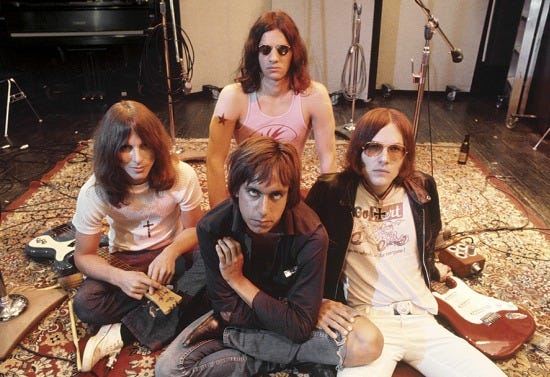Gimme Danger

Let me tell you what I know of Iggy Pop. When I was in college in New York City 25 years ago, a classmate and budding photographer showed me some pictures she'd taken of the singer at a local club. She was obviously mesmerized by him, I had a bit of an unrequited thing for her, so naturally a sort of transposed resentment became baked into the pie.
Iggy is a famous musician without a single top-charting song to his name. He's known to most of the public for his stage persona — always shirtless, seemingly whacked out of his gourd, doing weird contortionist dancing that he himself has described as an ape or monkey getting ready to fight.
He is believed to have pioneered the craft of stage-diving, aka jumping into a crowd of people — full tilt, totally horizontal — and hoping they catch him. Often they did not. Iggy has suffered smashed lips and noses, lost teeth and broken bones over the years. Still he keeps diving. There's sort of an insane poetry in that.
At the time, though, I was somewhat repulsed by this old dude who kept writhing around and pulling down his pants, threatening to show off his junk (though never quite going all the way). I should point out that Iggy then was about the same age I am now.
So I formed this dismissive impression of Iggy in my mind as one of those people famous for being famous. He showed up from time to time on TV and in movies, caterwauling atonally — basically, this grotesque thing people pointed at for their own amusement.
"Gimme Danger" is Jim Jarmusch's piercing of that gaudy disguise. In examining his 50-year career, focusing mostly on the early days with the Stooges, a portrait emerges of a serious musician who was constantly absorbing from other talents, and forming their contributions into something new.
A working-class kid from Ann Arbor, Michigan, Iggy grew up in a trailer home, pounding on drums so long his parents finally gave up the master bedroom just so they could put a door between them. Yet they were totally supportive and he still speaks of them with loving admiration.
Iggy and some other local teens — notably brothers Ron and Scott Asheton, James Williamson and Dave Alexander — started getting together in basements to practice, banging on oil drums or anything else they could to produce the harsh, percussive sound they craved. Their songs featured tight, hard beats that sometimes drifted off into psychedelic extended instrumentals.
Coming up during the age of gentle hippie music, Iggy and the Stooges formed part of the nascent backbone of hard rock. They put out three albums, none of them commercial successes, toured around, got hooked on drugs, and by the early 1970s the band broke up and most of the members went back home to live with their parents.
Jarmusch mixes archival footage and photographs with extensive modern interviews with Iggy, with whom he's enjoyed a long friendship — addressing him by his given name, Jim Osterberg.
We learn things we never would've guessed, such as Iggy's penchant for simple, repetitive lyrics coming from TV personality Soupy Sales, who encouraged kids to write him letters of 25 words or less. Iggy shows himself to be an impressive mimic, able to imitate other singers or instrumental riffs on cue.
One of my favorite sections is about Iggy moving from drummer to lead singer, and developing his signature style. For awhile he put his drum set on a huge pedestal, 15 feet above the stage, so he could stand out. Clearly, here was a guy who felt the call of the spotlight.
"Eventually, I just got tired of looking at somebody's butt all the time," he snickers.
Like most observers of Iggy, Jarmusch is entranced by his body. His camera swoons admiringly over his lithe limbs and lean torso; he was rock 'n' roll's original six-packer.
Iggy just has one of those rare physiques completely bereft of fat, so his skin seems to barely contain his muscles, tendons and veins. It's like he's popping out at you like one of those medical specimen mock-ups. He says that he was entranced by Yul Brynner in "The King and I," the notion of kings always going around bare-chested.
Nearly 70 now, Iggy looks pretty much the same as he did in the 1960s, other than his flesh loosening up here and there to develop a bit of a wattle. I doubt he's ever lifted weights or done any kind of strenuous exercise in his life; the man just seems to burn from a fire within.
"Gimme Danger" is a probing look at a peculiar pop culture figure who turns out to be way more than skin deep.



